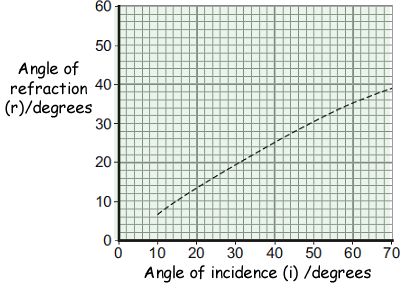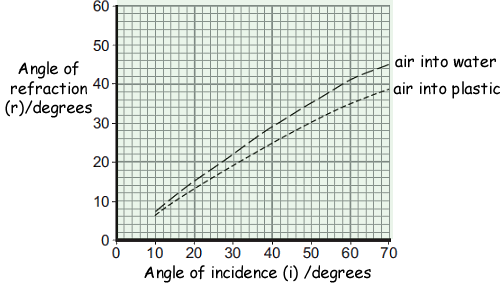GCSE questions on refraction
Q1. A student investigated the refraction of light in the laboratory.
(a) Use a ruler to draw the continuation of path of the light ray shown on the diagram below. You must show how it passes into and out of the clear plastic block.
(3 marks)

 The ray refracted into the block should be constructed with an angle of refraction smaller than the angle of incidence on the air/plastic boundary.
The ray refracted into the block should be constructed with an angle of refraction smaller than the angle of incidence on the air/plastic boundary. 
 The ray refracted out of block should be constructed with an angle greater that the angle of incidence on the plasitic/air boundary.
The ray refracted out of block should be constructed with an angle greater that the angle of incidence on the plasitic/air boundary.
 The ray entering the block and the one leaving the block should be parallel to each other for the final mark.
The ray entering the block and the one leaving the block should be parallel to each other for the final mark.

(b) The student measured the angle of refraction (r) for several different angles of incidence (i) for light entering the plastic block. The results are shown on a graph.

(i) What two conclusions can be made about the relationship between the angle of incidence and the angle of refraction from the graph shown above?
 The angle of refraction is smaller than the angle of incidence.
The angle of refraction is smaller than the angle of incidence. 
 The angle of refraction increases as the angle of incidence increases - there is a positive correlation between them (but they are not proportional as the line is not straight.
The angle of refraction increases as the angle of incidence increases - there is a positive correlation between them (but they are not proportional as the line is not straight. 
(2 marks)
(ii) This second graph shows the student's results for light passing from air into plastic. This graph also shows the results for light passing from air into water.

How does the refraction of light passing from air into water compare to the refraction of light passing from air into plastic?
 Light is refracted to a smaller degree by water than plastic
Light is refracted to a smaller degree by water than plastic 
(1 mark)
(c) In some countries people are too poor to pay for electricity. Some people living in small houses with no natural light are using bottles filled with water instead of light bulbs. The bottles are fitted into small holes in the roof of the house. Sunlight refracts as it passes into and out of the bottle, causing light to spread into the room. This simple device gives about the same amount of light as a 50 W light bulb.

(i) Suggest one way this simple device can help improve the lives of the people using it.
 Any sensible suggestion to do with being able to see inside (during daylight hours) was awarded a mark eg able to (see to) work or cook inside. It was accepted if you said 'to see what they are doing'.
Any sensible suggestion to do with being able to see inside (during daylight hours) was awarded a mark eg able to (see to) work or cook inside. It was accepted if you said 'to see what they are doing'. 
(1 mark)
(ii) The increasing use of energy resources to generate electricity within developed countries has ethical implications. Suggest one ethical implication.
Any ethical suggestion got you a mark. For example:
 fair access to energy should be for all
fair access to energy should be for all
 unequal use of energy resources - developed countries monopolise resources
unequal use of energy resources - developed countries monopolise resources
 consequences for the future of decisions made now
consequences for the future of decisions made now
 damage to global environment affects all
damage to global environment affects all
(1 mark)
(Total 8 marks)










